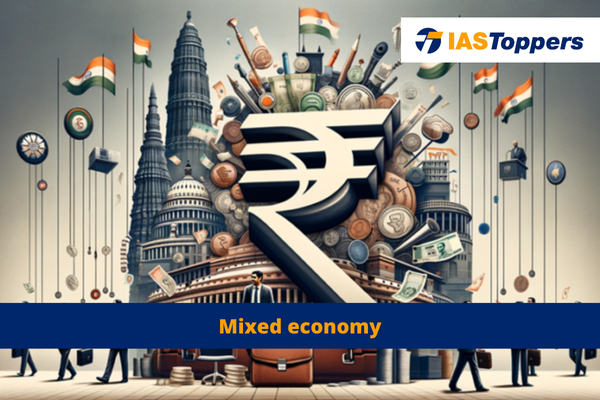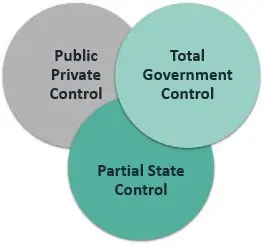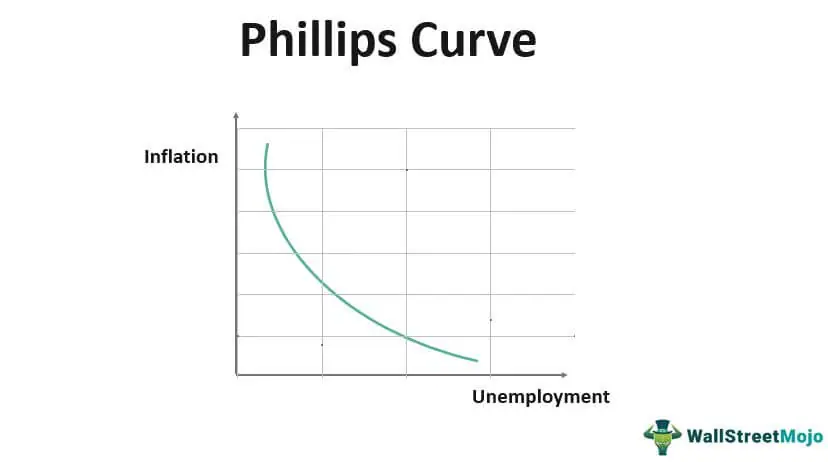Mixed economy is one in which an economic system combines elements of both capitalism and socialism. In this article, you will learn definition, characteristics, merits and demerits, difference between capitalism socialism and mixed economy, role of government.
This article will provide key insights for GS Paper-III Economy section of UPSC IAS Exam.
Table of Content
- What is Mixed Economy?
- Features of Mixed Economy
- Types of Mixed Economy:
- What do you understand by mixed economy?
- Mixed Economy vs. Free Markets
- Mixed Economy vs. Socialism
- Advantages of a Mixed Economy
- Disadvantages of a Mixed Economy
- Emergence and Critics of the Mixed Economy
- Real-World Examples
- India as a mixed economy type:
- Conclusion
- Frequently Asked Questions
- Reference
What is Mixed Economy?
- Mixed economy refers to an economic system that combines elements of both capitalism and socialism.
- Mixed economic system blends private property protection and economic freedom with government interference to achieve social goals.
- John Maynard Keynes is also known as father of mixed economy as the idea of such an economic development was first introduced by him.
Features of Mixed Economy
- In a mixed economy, elements of a market-based system are combined with a functional public sector.
- The primary focus in a mixed economy is on providing service rather than solely pursuing profit.
- The majority of prices are determined through the measure of supply and demand.
- However, the government can step in and influence the economy by establishing minimum prices (floor pricing) or maximum prices (price ceiling) for specific goods or by allocating public funds to certain industries.
- Some enterprises are owned by the state (public sector) while others are privately owned (private sector), and there may also be joint ownership of resources (joint sector).
- State formulates economic policies and ensures their implementation, protecting the legal rights of different interest groups, and resolves conflicts of interest.
- State also assumes an entrepreneurial role through public ownership and management of production and commercial enterprises, when the government provides public goods and services for the general population, where the profit motive may limit involvement of private sector.
- State has a planning role in allocating scarce resources according to the national priorities.
Programs for Social Well-being
- In mixed economies, various assistance is provided to individuals living near or below the poverty line or other marginalised community.
- Examples of assistance includes free to meagre fees of medical aid, insurance, socialsecurity, schooling, free skilling programmes, accidental benefits, subsidies, basic income etc.
Controlling Prices and Offering Subsidies
- Though market forces typically determine prices in a mixed economy, the government may step in to prevent certain commodity prices from exceeding or falling below a particular threshold.
- Examples: minimum wage laws are provided in many mixed economies to safeguard workers from exploitation, and subsidies may be implemented to assist farmers or other such industries.
Stringent Business Regulations
- Though majority of business activities are driven by market dynamics, governments enact regulations to safeguard the public against hazardous products, pollution, and monopolistic practices.
- Anti-trust laws are often present in mixed economies to ensure fair competition within the marketplace.
Types of Mixed Economy:
What do you understand by mixed economy?
- The public and private sectors may coexist, but they may compete for limited resources.
- Mixed economic systems allow the private sector to make profits while also contributing to the country through Corporate Social Responsibility (CSR) or Environmental, Social, and Governance (ESG).
- CSR or ESG type initiatives are most of the time provided in return of some other benefits including tax rebates.
- In reality, all historical and modern economies fall almost within the range of mixed economies.
- Pure socialism and pure free markets exist only as theoretical concepts.
Mixed Economy vs. Free Markets:
- Mixed economic systems differ from laissez-faire systems as they involve government participation in resource planning and control over private businesses.
- Governments may redistribute wealth by taxing the private sector and utilizing the tax funds to support social objectives.
- In mixed economies, government interventions such as trade protection, subsidies, targeted tax credits, fiscal stimulus, and public-private partnerships are common.
- These interventions serve as instruments to achieve specific goals that can succeed despite their distortionary effects.
- Countries often intervene in markets to promote specific industries by fostering clusters and reducing entry barriers to gain comparative advantage.
- This approach was prevalent amongst East Asian countries during the 20th-century export-led growth strategy.
- This has resulted in the region becoming a global manufacturing hub for various industries.
- Certain nations specialize in textiles, others in machinery, while some become hubs for electronic components.
- These sectors gained prominence as governments protected emerging companies and facilitated their growth to achieve competitiveness, alongside supporting related services like shipping.
Mixed Economy vs. Socialism
- Socialism involves the common or centralized ownership of the means of production.
- Supporters of socialism believe that through central planning, a greater good can be achieved for a larger number of people.
- Socialists lack trust in the results of free-market as proposed by classical economists.
- Socialists advocate for the nationalization of all industries and the seizure of privately owned capital goods, lands, and natural resources.
- In contrast, mixed economies rarely go to such extremes.
- Mixed economies identify instances where intervention could yield outcomes unlikely to be accomplished in free markets through measures such as price controls, income redistribution, and strict regulation of production and trade.
- Mixed economies socialize specific industries known as public goods, which are considered essential and may not be adequately provided by the free market.
- Examples include public utilities, military and police forces, and environmental protection.
- Unlike pure socialism, mixed economies maintain private ownership and control the means of production.
Advantages of a Mixed Economy
- Blending Capitalism and Socialism: The Mixed Economy combines the beneficial aspects of both capitalist and socialist systems, leading to desirable qualities.
- Capitalist principles like free enterprise, market-driven prices, and private property incentivizes innovation and efficiency, while elements of a welfare state and price controls ensure a basic standard of living.
- Social welfare programs can also impose a heavy tax burden and disrupt the market’s equilibrium.
- In a mixed economy, the government also influences its strategic priorities through selective interventions.
- Enhanced efficiency and productivity through market-driven incentives.
- Limited welfare safeguards for the most vulnerable segments of society.
- Empowers the government to establish strategic priorities via economic policies.
Disadvantages of a Mixed Economy
- Price controls, such as minimum wage laws, may unintentionally reduce employment, as explained by the Philips curve.
- Interventions like housing guarantees or free healthcare can sometimes lead to shortages due to inadequate pricing reflecting availability.
- Unintended consequence of government intervention is recurring shortages due to price controls, which ultimately lead to increased demands for further intervention.
- Mixed economies can face challenges such as reduced competition and regulatory capture, where private interests lobby for favourable regulations and tax benefits.
- This can result in regulations determined by industries rather than policymakers.
- Fails to eliminate the market-distorting effects of government intervention.
- Prone to regulatory capture as business interests advocate for favourable regulations.
- Imposes higher taxes to finance welfare state initiatives.
Philips curve:
Emergence and Critics of the Mixed Economy
- The concept of a mixed economy became prominent in the United Kingdom after World War II, although many policies associated with it were initially proposed in the 1930s.
- The Western economies had remained mainly capitalist due to the continuous cycle of capital accumulation.
- According to classical and Marxist theorists, the economy is driven by either the law of value or the accumulation of capital, or by non-monetary forms of valuation.
- Austrian economists– Ludwig von Mises, have argued that a mixed economy countries are unsustainable and mixed economy tends towards a more socialist state over time.
Real-World Examples
- Nearly every country can be classified as a mixed economy including North Korea, as government intervention or market activity is vital for sustaining economic functioning.
- By the late 1980s and the 1990s, very few economies could be classified as purely capitalistic or completely Socialistic.
- The main examples of mixed economies emerge in countries where the government significantly influences the market-driven economy.
- Several Western European nations are recognized as mixed economies due to their extensive welfare programs and strict business regulations.
- Also, many socialist-leaning countries also qualify as mixed economies due to the presence of the private sector.
- China and Vietnam have privatized many state-owned enterprises while retaining government leadership in economic affairs.
India as a mixed economy type:
- In India, a notable aspect of the mixed economy is the production of goods and services by both public sector enterprises and the private sector in fields such as steel, chemicals, textiles, as well as banking, insurance, healthcare, and education.
- India has been democratically socialistic with welfare government type since independence which serves as an example of mixed economy.
- India has adopted mixed economic policy through passing the Industrial policy resolution 1948.
Conclusion
The concept of mixed economy relates to combination of many elements of both capitalism and socialism. A mixed economy is necessarily a planned, organised and controlled. Neoclassical theory suggests that mixed economies are less efficient than pure free markets. However, advocates of government intervention argue that practical application often falls short of the ideal conditions necessary for efficiency of free market, such as equal information and rational market participants.
Ref: Source-1
| Other Articles in Economy | |
| Capitalism | Aviation Industry in India |
| Economic Impact of British Rule in India | Electoral Bonds |
| Minimum Support Price (MSP) in India | Cash Crops |
FAQs (Frequently Asked Questions)
What do you mean by mixed economy?
Mixed economy means an economy where there iscombinationof elements of both capitalism and socialism.
What is the role of money in a capitalist and mixed economy?
Money acts as a mobilising agent in both of these economies as it increases resources, generates new resources and channelizes resources into productive uses.
Why did India opted for mixed economy?
India has a mixed economy due to the reason that the economists of India in pre-independence has already known the fallacy of Capitalist system that has led to the colonisation of India and also India aimed to become a democratic nation which is not in consonance with the principles of socialism. This resulted in India opting for mixed economy.
In which five year plan did India opted for mixed economy?
India had adopted a mixed economy during its second five-year plan.
What are the three types of mixed economies?
Types of mixed economies are Partial State Control, Total Government Control, Public-Private Control.
What are some characteristics of a mixed economy?
The majority of prices are determined through the measure of supply and demand, but government may step in whenever necessary to control the prices of such goods. Government launches programs for social well-being of its citizens.
How are resources allocated in a mixed economy?
In mixed economy, resource allocation is decided by a combination of market forces and government intervention.
Why is China a mixed economy?
China is considered a mixed economy as it allows private sector based company to grow and expand but they are also under the regulations of Chinese government.




